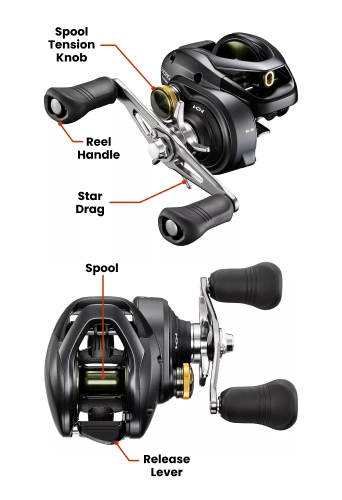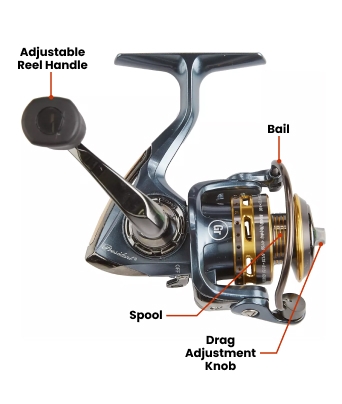Baitcaster vs Spinning Reels: What’s the Difference?
Baitcasting vs Spinning Reels Comparison
“Get a spinning reel” is what most novice fishers likely hear when it comes time to upgrade from a push-button spincasting reel. But not all beginners are alike. Muster up some patience. Pair that with enough practice. You might find yourself tempted to dart for that baitcasting reel instead.
There are three main differences between a spinning reel vs a baitcasting reel: how they’re individually built and designed to function, how they mount to your fishing rod when in use, and how they cast as you throw them out into the water.
Whether you’re simply curious or you’re seriously considering moseying down your own path, here’s everything you should know about the differences between baitcasting and spinning reels:
Expert Tip:
Your casting style plus the fish species you plan to catch dictate which type of reel you need to choose.
What Is a Baitcasting Reel?
By design, baitcast reels sit on top of your rod and work with the weight of your bait or lure while the fish pulls on the line. A smooth spool spins rapidly when you release the line.
The unique spool rotation yields a greater, more accurate casting distance with a lesser likelihood of line tangling and twisting. Experienced anglers who prefer using heavier lines or catching larger and stronger game fish (like largemouth bass) will enjoy using them!
“ Baitcasting reels are phenomenal because they increase accuracy, increase casting distance, and increase sensitivity, which comes in extra handy when throwing artificial lures. ”
- Saltwater Expert, Captain Michael "Sharky" Marquez

Parts of a Baitcaster Reel Explained
-
Reel Handle: A feature unique to baitcasting reels is that they have two reel handles. This makes it easier to grab a hold of the opposite handle if your grip slips on the first.
-
Star Drag: The star drag simply adjusts the reel spool’s tension when it’s locked.
-
Spool Tension Knob: The spool tension knob controls how quickly or slowly your bait descends out of the spool.
-
Release Lever: The release lever is where your thumb rests. It controls when the spool releases and is ready to cast.
-
Spool: A spool holds the line. Baitcasting reels often come in a variety of sizes. This gives you plenty of options to choose from, so you have the best line capacity.
What Is Gear Ratio on a Reel?
Gear ratios refer to how many times a fishing reel’s spool rotates per handle turn. Lower gear ratios have slower retrieval. Higher gear ratios have faster retrieval. A hallmark feature of a baitcaster reel is that it offers different gear ratios, which does present a steeper learning curve when throwing one.
How To Cast a Baitcaster Reel
-
Step 1 - Before you cast, check the spool tension adjustment knob is appropriately set.
-
Step 2 - Make sure your bait/lure is at least 12-18 inches away from the tip of your rod.
-
Step 3 - Press down on the release lever. Keep your thumb resting against the spool.
-
Step 4 - Pull your rod back so that your rod is back roughly 180 degrees. When you’re ready, swing it forward with good force and movement. Keep a light pressure on the thumb resting on your spool so the line moves freely.
-
Step 5 - When your bait hits the water, lock the spool in place by turning the reel handle accordingly.

When Should You Use Baitcaster Reels?
Baitcasters are typically better suited for big game fishing and other heavy lifting. This specific type of reel can be used in many of the same scenarios as spinning reels; although, they are a popular choice for freshwater bass fishing.
What Is a Spinning Reel?
Spinning reels mount to the underside of a fishing rod. Not only are they surprisingly easier to handle compared to baitcast reels. Beginner anglers can enjoy a smaller learning curve, better control, and fewer tangling opportunities.
The spool of a spinning reel does not physically rotate. Instead, the bail mechanism spins as you turn the handle on the side of the reel. They have an anti-reverse mechanism that prevents the line from unraveling when you get a bite.
“ Spinning reels are great for beginners! They're easy to use, easy to cast, and ideal for high-wind situations. I like to use them for fishing live bait. They’re even universal for right-handed or left-handed fishers. ”
- Saltwater Expert, Captain Michael "Sharky" Marquez

Parts of a Spinning Reel Explained
-
Adjustable Reel Handle: The adjustable reel handle makes it easy to switch sides on the reel — accommodating both right- and left-handed fishers.
-
Drag Adjustment Knob: The drag adjustment knob controls the spool resistance. Turn right to tighten it, or turn it left to loosen the line.
-
Spool: The spool is where the line goes. You’ll find different spool sizes that depend on your fishing style or the species you’re after.
-
Bail: The bail is a mechanism used to release or stop the line from moving in or out of the spool.
How To Cast a Spinning Reel
-
Step 1 - Reel in your line so that it lines up with the bottom of the rod.
-
Step 2 - Pinch the line with your pointer (or index) finger against the rod.
-
Step 3 - Reach over and flip the bail. Keep in mind that your pointer finger is the only thing holding up your line.
-
Step 4 - Bring your rod back. But wait! You want to feel the weight of whatever bait or lure you’re using.
-
Step 5 - Once you feel that weight, swing it forward like you’ve just hit that epic home run. Be sure to also release the line from your finger as soon as both the rod and reel are in front of you.
-
Step 6 - When the bait/lure hits the water, close your bail back to its original position.
-
Step 7 - Reel the slack from your line, and wait for that fish to bite!

When Should You Use Spinning Reels?
Use spinning reels for almost any type of fishing — from spin fishing and trolling to bottom fishing or even offshore fishing. Baitcasters can generally be cast further and more accurately than spinning reels. However, spinning reels are useful for shallow waters, windy conditions, or when any extra finesse may be required.
Differences Between Spinning Reel vs Baitcaster
| Baitcaster vs Spinning Reel Guide |
|||||
|---|---|---|---|---|---|
| Category | Baitcaster Reel | Spinning Reel | |||
| Skill Level | Better for intermediate fishers (takes more time to master) | Best for beginners (easier to use) | |||
| Casting Distance | Longer and more accurate casting distance | Average casting distance capabilities | |||
| Best Line Type(s) | Heavier lines and braided line | Suitable for most line types | |||
| Best Lure Type(s) | Heavier-weight lures | Lighter-weight lures | |||
| Spool Type | Inline; drag system adjusts the spool to the correct level of resistance needed | Open; fixed upright | |||
| Ideal Fish Size(s) | Great for handling larger, trickier fish | Ideal for small- to medium-weight fish | |||
| Price | Often more expensive | Often more affordable | |||
| Mount | Mounted on top of rod | Mounted underneath rod | |||
| Line release | Thumb bar line release | Anti-reverse switch | |||
| Maintenance | Requires more maintenance | Easier to maintain | |||
Baitcast reels require the pressure of your thumb on the release lever to keep it from unspooling. They work with the weight of your bait or lure as it pulls on the line.
Baitcasting Reel Pros ✓
-
Long casting distance + better accuracy
-
Excellent drag system
-
All fishing line types compatible
-
Good control system and balance
-
Best suited for heavy lures
-
Lighter weight than similar-sized spinner reels
Baitcasting Reel Cons ×
-
Steeper learning curve for beginners
-
Requires greater dexterity when switching hands
-
More expensive than other reel types
-
Complex construction + design
-
Must change braking system and spool settings when you switch lure types
-
Higher risk of backlash while casting
Spinning reels have an anti-reverse mechanism called a bail, which is helpful in preventing your line from unraveling when you get a bite.
Spinning Reel Pros ✓
-
Very easy to use and maintain
-
Better control + improved power
-
Ideal for casting with lightweight lures and lines
-
Spool is easily changed
-
Less risk of backlash while casting
Spinning Reel Cons ×
-
Not suitable for heavy lines or lures
-
Less casting distance and accuracy
-
Not great for big game fish
-
Heavier in weight overall than similarly sized baitcasters
What Is the Best Fishing Reel?
The best fishing reel is the one that works for you. When it comes to fishing, “best” will always be subjective — highly dependent on an individual angler’s current skill, knowledge, casting style, and preferences.
The experts here at Academy Sports + Outdoors recognize that there are a myriad of ways (be it generational secrets or widely-known strategies) to catch that fish. Fishing dates back more than 40,000 years. It’s seen obvious, substantial transformations over that time in what it looks like.

Have Fun Out There!
The reality is that beginners can’t learn without those moments of trial and error. This beloved pastime is — for the better — shaped through continued learning and passing on those lessons. If you’re ready to level up your fishing game, learn more about the other types of fishing reels or check out our 21 best fishing tips for beginners.